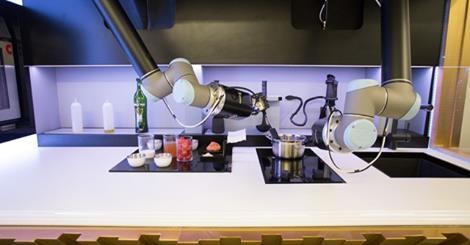Tomorrow's kitchen is here today. The United Kingdom company Moley Robotics has unveiled a prototype of the world's first robotic kitchen that can prepare a MasterChef winner's crab bisque.
The company plans to launch a consumer version of the kitchen in two years. One week ago, Moley's invention was showcased in London during the Hanover Messe industrial robotics show, according to The American Register.
Basically, the Moley Robotic Kitchen basically consists now of two very pricey robotic arms. At the end of the arms are two humanoid hands. All the equipment a human chef would need is located in front of the robotic arms. They include an oven, stovetop, small appliances, and a sink, according to Ars Technica.
The robot's operator must place the ingredients in bowls and cups sitting on the worktop. Then the engineer presses "start" on the PC that operates the robot. In about half an hour the robotic arms can whip up a tasty crab bisque.
The Robotic Kitchen is actually copying the precise movements of Tim Anderson. He was the winner of the TV show "MasterChef" in 2011.
After using motion-capture cameras to record Anderson's bisque preparation, Moley saved the clearest movements in a database. A PC that runs the Robotic Operating System (ROS) then executes the database.
There is no room for error. For example, if the ingredients are set up in the wrong place, the robot will pick up crab instead of cream. And If the saucepan's position is a few millimeters off, the robot will grab nothing but air molecules.
Moley is hoping to produce the robots' arms and hands more cheaply. Then it could sell a complete Robotic Kitchen for £110,000 ($14,600).
One possible improvement would be computer vision. That would make the robot's operation more consistent and safer.
The consumer version of the robotic kitchen will have an "iTunes style library" of recipes available. Mobile users would order their robot chef to prepare a downloaded recipe.
The big question is if the Robotic Kitchen passed the ultimate test-the approval of Anderson himself. When asked if the robot's bisque was better than his, he described the machine's as "more reliable."



























